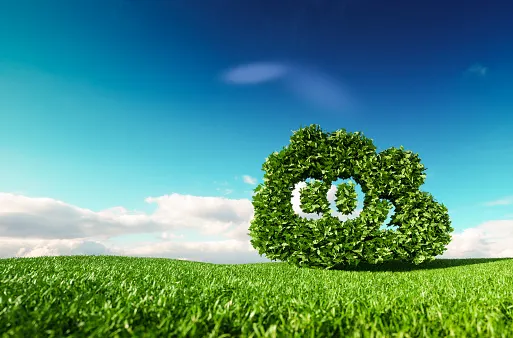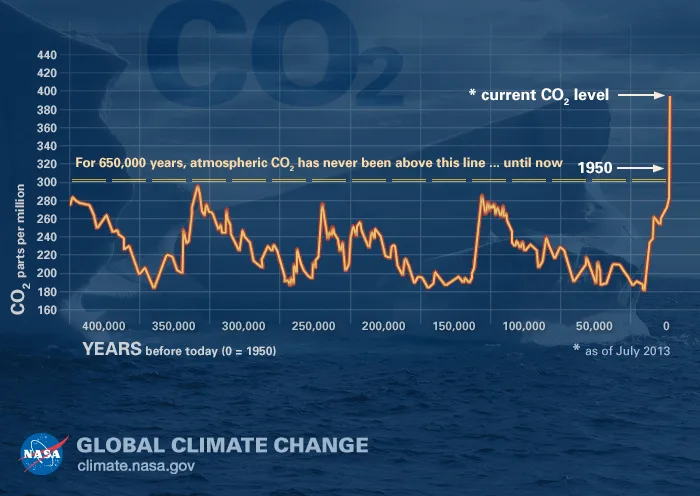
Four ways that climate change is making our allergies worse
"As the concentration of carbon dioxide increases in the atmosphere, studies are showing that the amount of pollen produced, per plant, is going up."
Take heed, allergy sufferers! Even as you feel the impacts of the pollen filling the air during spring and summer, climate change is making things worse, in four important ways.
It's trees during the spring. Grasses in early summer. And then there's the dreaded ragweed in late summer and early fall. The greener seasons can be miserable ones for a large sector of the population, as they suffer due to pollen filling the very air that we breathe.
To make matters worse, there's evidence that climate change is stacking the deck against allergy sufferers, in four key ways:
Longer allergy season
More pollen
Greater pollen "potency"
Migration of allergenic species
1) LONGER ALLERGY SEASON
With the Earth getting warmer, this is causing the periods of time when certain plants bloom - what we define as 'allergy seasons' - to get longer.
"In Canada, on average, over the past 15 years or so - in particular with ragweed - the data that I've seen shows about a 1-month increase in the length of the allergy season," says Prof. Michael Brauer, from the University of British Columbia's Faculty of Medicine and School of Population and Public Health.
According to Brauer, this trend continues across the United States, as well, however the farther south you go, the less of an increase in the season you see.
"It's particularly pronounced, the farther north you get, and the colder the climate gets," he said.
This trend pairs well with the evidence we've been seeing, already, with how northern climates are seeing the largest, fastest effects from global warming and the resulting climate change - with the Arctic warming at roughly twice the rate that is seen in other parts of the world.
RELATED: Why have I developed allergies all of a sudden?
2) MORE POLLEN
Perhaps you've heard of the 'pollen vortex'? Or you've seen videos online, showing the huge clouds of pollen pine trees are releasing with just a little shake?
If you're thinking that this is something we've only been seeing more recently, it's not your imagination. Climate change is causing this as well, but it's not as a result of the temperature.
"It's not necessarily the warmer climate," Brauer says, "but the more carbon dioxide."
According to Brauer, as the concentration of carbon dioxide increases in the atmosphere, studies are showing that the amount of pollen produced, per plant, is going up.

Graphic: The inexorable rise of carbon dioxide levels in the atmosphere. Ancient air bubbles trapped in ice enable us to step back in time and see what Earth's atmosphere, and climate, were like in the distant past. They tell us that levels of carbon dioxide (CO2) in the atmosphere are higher than they have been at any time in the past 400,000 years. Credit: Data: National Oceanic and Atmospheric Administration. Some description adapted from the Scripps CO2 Program website, "Keeling Curve Lessons."
It's not just that there's more pollen, though.
3) GREATER POLLEN "POTENCY
Each pollen grain itself has been found to be more allergenic, or more potent, when it comes to causing allergic reactions in people who are sensitive, Brauer says.
"There's little molecules on the pollen grains, which are reacting with receptors, and there's more of these molecules per pollen grain," Brauer explained.
Again, due to the increase in carbon dioxide concentrations in the air, the pollen grains of different species of plants are producing more of the chemical molecules that cause a histamine reaction from the immune system of allergy sufferers.
So, even as more grains of pollen are filling the sky, each of those grains is more allergenic than they once were.
For those people who have only had mild seasonal allergies in the past, this combination of more pollen, and more allergenic pollen, may be causing them to have more severe reactions in recent years, and their reactions could become even worse in the years to come.
For those who already suffer from severe seasonal allergies, they may not be affected quite as much as someone who is used to experiencing more mild reactions - both due to the precautions and treatments they are already taking to alleviate their exposure and symptoms, but also because their immune system is already producing the maximum possible reaction per exposure.
4) MIGRATION OF ALLERGENIC SPECIES
If you live in a region where ragweed and other allergenic plants are not usually found, and thus seasonal allergies haven't been a problem for you, you may not be so lucky, for much longer.
As the planet warms, due to climate change, climate regions are expanding and migrating farther north. As this happens, the plant species that thrive in those regions are migrating along with them, and thus being introduced into regions of the world where they were previously absent.
"One of the things this is going to mean for allergy sufferers, is that people with ragweed sensitivity, for example, who live in a place where there is no ragweed, are fine, for now," Brauer said. "It may be that ragweed will move into their area, over time, and they begin to suffer."
Thus, rising temperatures may actually result in greater numbers of allergy sufferers, as more people who are unknowingly sensitive to these plants, suddenly become exposed to them for the first time.
According to Brauer, it is also possible that some species that are the most allergenic may not be able to survive, or be as plentiful, in either the new regions they might spread into, or their traditional regions of the world, as those regions experience climate change.
"So, that's a little harder to predict, exactly," he said.











